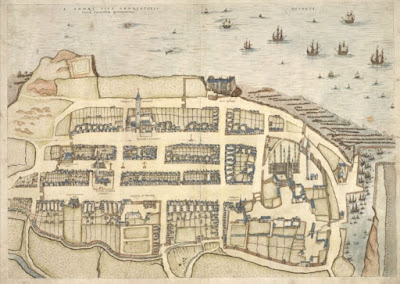 |
| Mary Queen of Scots |
 |
| Queen Mary's House |
 |
| Map of St Andrews c1580 |
Mary’s association with St Andrews also involves a further French connection - the execution in the centre of the town in 1563 of Pierre de Boscosel de Chastelard. He was a French poet at Mary’s court who, on two occasions, entered the queen’s bed chamber. The second incident, occurring at Rossend Castle in Burntisland in Fife, resulted in his condemnation and, at the age of 22, he was brought to St Andrews for execution. It is uncertain whether Chastelard was simply a hot-headed young man infatuated with the regal figure of Mary or whether more sinister factors motivated his actions.
A thorn bush in St Mary’s quadrangle, further along South Street, was reputedly planted by the queen during one of her visits to the town.
Cross South Street but, before turning into South Castle Street, note Jannetta’s Gelateria, a short distance along South Street, renowned for its Italian ice cream. The Italian family business was established in St Andrews in 1908. In South Castle Street take the first left into Market Street and walk up to the junction with Church Street. The modern building on the corner of Union Street is home to the University of St Andrews School of Modern languages offering degree courses in major European Languages, including Russian.
Mary Queen of Scots portrait by François Clouet, public domain, via Wikimedia Commons
Queen Mary's House image courtesy Paul Vyšný
Geddy map reproduced with the permission of the National Library of Scotland
